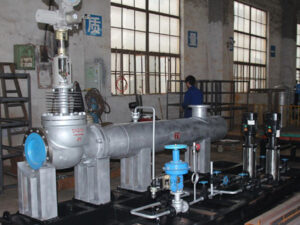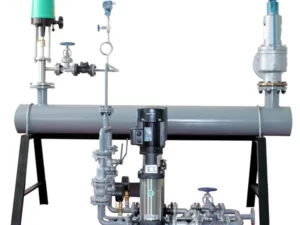Steam pressure reducing station
Product Details
What is pressure reducing station?
Steam pressure reducing station, or PRV station in short, is designed to receive high pressure steam and reduce it to desired condition. PRV station is usually prefabricated assembly, which is easy to install and ready to use.
Due to excellent heat transfer efficiency, steam is widely used as heating & drying medium for various purposes, such as district network heating, plant process application in food, paper, textile, brewery, chemical, pharmaceutical, petrochemical, etc. An individual steam generator could produce steam that matches with consumer requirement (temperature, pressure, flow). But steam supplied from power plant normally has a higher pressure than what is required by downstream process. A steam pressure reducing station is a solution for this problem.
Why high pressure steam is required during transportation?
- To deliver the same flow of steam, if pressure is higher, it means smaller pipeline diameter, less investment on pipes and installation.
- Smaller pipeline diameter would result in less heat loss and less insulation cost.
- Steam with higher dryness can be obtained at site after pressure reduction.
Why low pressure steam is preferred by consumer?
- Steam has higher latent heat under lower pressure. It means higher utilization of thermal energy.
- Less water particle entrainment, less condensate drainage, higher steam quality.
- Equipment doesn’t need to bear a high pressure.
- High pressure means higher leakage.
Pressure reducing valve components
Steam pressure reducing station is more than a control valve, especially when steam varies greatly. A properly designed PRV station should have correct selection of the components, because every component is indispensable in the system.
- Separator: reduce moisture particle entrainment to avoid erosion to valves and fittings.
- Drain valve: condensate drainage.
- Strainer: remove impurities like welding slag, mill scale to avoid jamming in pipe & valve.
- Isolation valve: installed both upstream and downstream of control valve. It ensures system is closed during maintenance & repairment.
- Pressure gauge: installed both upstream and downstream of control valve to indicate pressure.
- Safety valve: installed downstream of control valve. It protects downstream equipment from damage when control valve is in failure.
- Bypass: it provides an optional route for steam flow at emergency.
- Control valve: namely pressure reducing valve. It has different types for choice, and each has their own pros and cons.
Pressure reducing valve selection guide
Manual control valve could be a pilot operated valve that changes steam pressure by changing pressure applied to spring inside pilot valve. It is simple structure and small investment, but stability is not so good when steam pressure is varying.
Direct acting valve doesn’t need any external force for pressure reducing. A higher or lower pressure than setting value would act on actuator diaphragm to adjust opening of disc. Thus, downstream pressure is maintained stable. Self acting valve is featured with quick action, good sealing, convenient operation, etc.
Pneumatic or electric PRV makes remote control possible. Pressure reducing is under control by PLC or locally. Pneumatic valve could work in a harsh environment, while electric valve is featured with compact structure, precise control.
Serial connection VS parallel connection
Normally, single pressure reducing station is enough for process applications. But in some cases, steam PRV station would be better in serial or parallel connection.
Parallel connection
If ratio of system maximum and minimum flow rate is bigger than 10:1, two steam PRV station in series is worth your consideration. When steam flow is low, only one station is in operation. When consumers have higher requirement for steam, the other station will be put into operation.
Serial connection
When turndown ratio is higher than 10:1, pls consider serial connection. Because high steam velocity will cause erosion to valve disc and seat, create big noise.
Steam pressure reducing station features:
- Customized to meet requirement of each individual client.
- Robust structure, compact size.
- Proper calculation & sizing by professional expert.
- PRV station equipped with pneumatic control valve could work in a harsh environment.
- Carefully selected valves and fittings to get steam at designed condition.
- Quick response to pressure fluctuation.
- Advanced design to make sure noise is lower than 80dBA.





